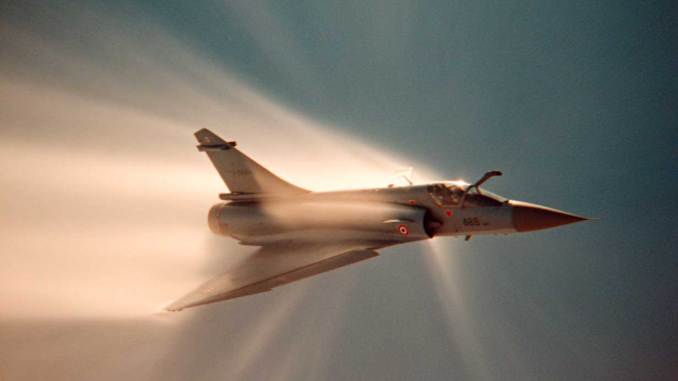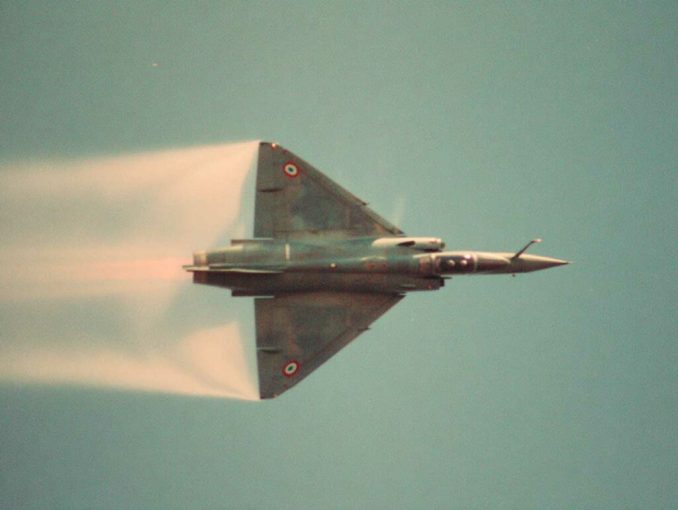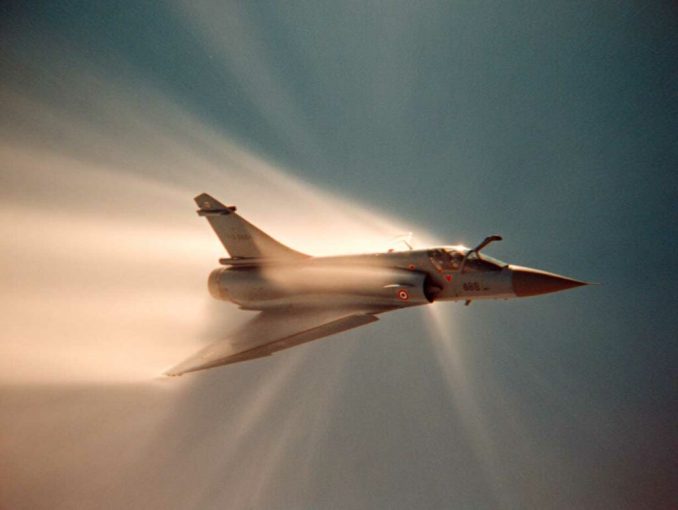
Discover the physical sensations and aerodynamic effects experienced by a pilot when breaking the sound barrier and flying at supersonic speeds.
In summary
Breaking the sound barrier—Mach 1, approximately 1,225 km/h at sea level—marks an iconic milestone in military aviation. Contrary to the idea of a sudden shock, the pilot of a supersonic fighter jet does not generally feel a sudden transition when breaking the sound barrier, apart from variations in acceleration during the thrust phase. The main physical sensations are related to acceleration, the decrease in air density at altitude, and G-forces during maneuvers. At constant speed, once stabilized at Mach 1 or above, the flight becomes relatively smooth again. However, breaking the sound barrier is marked externally by the sonic boom, a sound phenomenon that is not perceived in the cockpit. Modern aircraft such as the Rafale, F-16, and MiG-29 reach Mach 1 in a smooth, gradual climb, while older interceptors such as the F-104 and MiG-21 experienced more abrupt acceleration, which was more demanding for the pilot.
The sound barrier and its physical characteristics
Mach 1 corresponds to the speed of sound, which varies depending on air density: approximately 1,225 km/h at sea level and 1,060 km/h at an altitude of 11,000 m. An aircraft is said to be supersonic when it exceeds this threshold.
Below Mach 1, air flows subsonically around the airframe. As this speed is approached, compression waves appear, increasing drag and requiring greater thrust. Once the threshold is crossed, the flow stabilizes again, which explains why the pilot does not perceive a physical “wall.”
The effect is most spectacular on the ground: supersonic flight generates a sonic boom, a shock wave that sounds like an explosion but is not felt by the crew. Fighter cockpits are designed to maintain a stable, pressurized environment with no perceptible vibrations once the speed is reached.

Acceleration to Mach 1 and the associated sensations
What the pilot feels most intensely is not the flight at Mach 1 itself, but the acceleration required to reach it.
- In a fighter jet such as the Rafale, acceleration from Mach 0.9 to Mach 1.2 takes approximately 30 to 50 seconds in afterburner.
- The pilot then feels a continuous dorsal thrust and sometimes a slight vibration caused by shock waves on the airframe.
- This phase remains comfortable compared to the forces felt during tight maneuvers.
The acceleration generates a force equivalent to an additional 0.2 to 0.4 G in the longitudinal axis, which is much lower than the 5 to 8 G experienced during tight turns in aerial combat. The sensation is therefore that of a gradual thrust, without violent jolts.
Stabilized flight at Mach 1: a surprisingly normal environment
Once the aircraft has stabilized at supersonic speed, the pilot feels little difference compared to fast subsonic flight. Cabin pressure and ergonomics remain unchanged; the body does not perceive speed due to the lack of visual cues.
What distinguishes supersonic flight is above all energy management: the slightest maneuver consumes more fuel, and the pilot must anticipate longer trajectories for course changes.
The aircraft itself is subject to thermal stresses: at Mach 1, the surface temperature increases by about 40°C, without the pilot feeling it. Physical exertion does not increase as long as the aircraft is flying in a straight line at a constant altitude.
The effects of maneuvers at supersonic speeds
It is during high-speed maneuvers that the pilot experiences the most demanding physical effects. G-forces quickly become restrictive.
- At Mach 1 in a 5 G turn, the pilot experiences a force equivalent to five times their weight, compressing the chest and reducing blood flow to the brain.
- Anti-G suits and specific breathing techniques are necessary to prevent loss of consciousness (G-LOC).
Tolerance to these forces depends on training and physical condition; most fighter pilots can withstand peaks of 7 to 9 G for short periods. This factor, more than speed, is the main physiological constraint of supersonic flight.
Comparison with faster aircraft
Fourth-generation fighters such as the F-16, Rafale, and Typhoon routinely fly between Mach 1.2 and Mach 1.8 on interception missions. At these speeds, the sensation remains similar to that described above.
Aircraft designed for higher speeds, such as the MiG-25 and SR-71 Blackbird, have regularly flown at speeds exceeding Mach 2.5. Pilots report a stable environment during straight flight, but longer acceleration procedures and increased thermal stresses on the airframe and cockpit glazing.
Older interceptors, such as the F-104 Starfighter, were known for very sharp accelerations, causing more abrupt but brief transitions. These differences are due more to the design of the aircraft than to the speed itself.
The role of altitude in sensations
Altitude influences the speed of sound: the colder and less dense the air, the lower the speed corresponding to Mach 1. Thus, breaking Mach 1 at an altitude of 12,000 m requires approximately 1,060 km/h, compared to 1,225 km/h at sea level.
As air density is lower at altitude, aerodynamic forces and therefore vibrations are reduced. Supersonic flight is often more comfortable at high altitude than in the lower atmosphere, where turbulence and air density generate more stress on the airframe and the pilot.
This is also why most fighter jets reach Mach 1 or more during climb, where available thrust and low air resistance facilitate acceleration.
Breaking the sound barrier: myth and reality
The expression “breaking the sound barrier” evokes a sudden barrier. In reality, the effect felt by the pilot is moderate. It was mainly the first generations of supersonic jets that experienced significant vibrations when approaching Mach 1, due to a lack of suitable airframes and aerodynamics.
Today, the transition is smoothed out thanks to digital flight controls and the sleekness of the wing profiles. The sonic boom, spectacular on the ground, produces no particular shock or noise for the pilot.
This contrast between public perception and operational reality explains the continuing fascination with supersonic flight: it is a symbolic milestone of air power, rather than a sensory event for the crew.

A technical and psychological threshold for military flight
For military pilots, breaking Mach 1 is less a physical challenge than an indicator of performance and mastery. However, the supersonic experience requires increased vigilance in terms of anticipation: at more than 300 m per second, an error in trajectory or altitude translates into a significant deviation in a matter of seconds.
Pilot training emphasizes mental preparation and environmental management, because at these speeds, instrument reading and communication must remain fluid despite the rapidity of external events.
Thus, breaking the sound barrier remains an essential milestone in military aviation culture, symbolizing technical expertise and discipline rather than a spectacular sensation.
A field set to evolve
Future 6th generation fighters and certain supersonic drones promise to reach speeds in excess of Mach 2 without a pilot on board, which will transform human perception of this threshold.
For today’s crews, the challenge is no longer to break Mach 1 but to maneuver effectively at high speed, maintaining situational awareness in increasingly saturated combat environments.
This technological evolution reminds us that, behind the symbolic feat of supersonic flight, the human factor remains central to fully exploiting the potential of modern fighter jets.
Live a unique fighter jet experience
